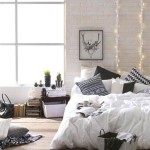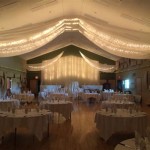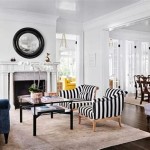How To Decorate A Room Painted Black
Painting a room black is a bold design choice, instantly creating a space that feels dramatic, sophisticated, and undeniably stylish. However, decorating a room painted black requires careful consideration to avoid creating a space that feels overly dark, oppressive, or even smaller than it is. Balancing the intensity of the black paint with light, texture, and strategically placed accents is key to achieving a harmonious and inviting atmosphere. This article will explore the various techniques, considerations, and elements needed to successfully decorate a room painted black.
1. Light is Paramount: Maximizing Natural and Artificial Illumination
Lighting is arguably the most crucial element when decorating a black room. Black absorbs light, therefore creating a dim space without proper illumination. The goal is to combat this absorption and create a bright, welcoming environment. Begin by maximizing natural light. Sheer, light-colored curtains or blinds can allow sunlight to filter through while maintaining privacy. If possible, consider using mirrors strategically to reflect and amplify the available light. Large mirrors placed opposite windows can dramatically increase the perceived brightness of the room.
Implementing layered artificial lighting is also essential. Avoid relying on a single overhead light source. Instead, incorporate a combination of ambient, task, and accent lighting. Ambient lighting provides general illumination. This can be achieved through ceiling-mounted fixtures, recessed lighting, or even floor lamps. Task lighting serves a specific purpose, such as a desk lamp for reading or a spotlight over a piece of artwork. Accent lighting highlights architectural features, artwork, or other decorative objects. This can be achieved through picture lights, track lighting, or small spotlights. Dimmer switches are highly recommended for all artificial light sources, as they allow for adjustable levels of brightness throughout the day and evening, providing flexibility in creating the desired ambience.
2. Color Contrast: Incorporating Light and Bright Accents
While the black paint provides the foundation, incorporating contrasting colors is vital to prevent the room from feeling gloomy. Choosing a palette with lighter hues will provide a visual balance to the dark walls. White, cream, grey, beige, and pastel colors are all excellent choices for furniture, accessories, and textiles. A white sofa against a black wall, for instance, creates a powerful visual impact and prevents the space from feeling overly dark. The key is to distribute these lighter colors strategically throughout the room to prevent them from being overwhelmed by the black.
Consider incorporating pops of vibrant colors as accents. These can be used to create focal points and add personality to the room. Bright pillows, throws, artwork, or decorative objects can inject energy and interest. However, keep the color palette cohesive. Avoid using too many different colors, as this can disrupt the sense of harmony. A curated approach is always best, allowing the selected accent colors to complement, rather than compete with, the black background.
3. Texture: Introducing Depth and Visual Interest
Black can sometimes make a room appear flat if not thoughtfully paired with differing textures. Textural elements are crucial for adding depth, interest, and visual variety to a black room. Incorporate fabrics with varied textures, such as velvet, linen, wool, or silk. A plush velvet armchair, a linen sofa, or a textured rug can add warmth and tactile appeal. Consider the use of patterned wallpaper, such as one with a glossy or metallic finish, to break up the expanse of the black wall and add a layer of richness.
Introduce natural textures through the use of wood, stone, or metal. Wooden furniture, particularly pieces with warm undertones, provides a welcome contrast to the black walls. Stone accents, such as a fireplace surround or a coffee table made from natural stone, add a touch of elegance and earthiness. Metallic accents, such as gold, silver, or copper, can reflect light and add a touch of glamour. A variety of textures will prevent the room from feeling monotonous and create a visually rich and engaging space.
4. Furniture Selection: Scale and Proportion are Key
The scale and proportion of the furniture are essential in any room, but particularly so in a black room. Avoid using furniture that is too small or too large for the space. Oversized furniture can overwhelm the room and make it feel cramped. Conversely, undersized furniture can get lost against the dark backdrop. Carefully measure the space and select furniture that is appropriately sized for the room. Consider the height and width of the furniture and how it relates to the scale of the walls and ceiling.
Consider the style of the furniture. Contemporary and minimalist styles can work particularly well in black rooms, as they often feature clean lines and simple forms that complement the sophisticated aesthetic of the black walls. However, other styles, such as mid-century modern or even traditional styles, can also be successful, provided they are thoughtfully chosen and appropriately scaled. The style of the furniture is ultimately a matter of personal preference, but it should be consistent with the overall design vision.
5. Artwork and Accessories: Strategic Placement for Visual Impact
Artwork and accessories serve as the final touches that complete the room’s aesthetic. Artwork provides an opportunity to introduce color, texture, and personality. Select artwork that complements the overall color palette and style of the room. Large-scale artwork can create a dramatic focal point, while a gallery wall of smaller pieces can add visual interest to a bare wall. Consider using artwork with light-colored mats or frames to further brighten the space.
Accessories should be carefully selected to add visual interest and functionality. Decorative objects, such as vases, sculptures, and candles, can be used to add a touch of personality and style. Mirrors, as previously mentioned, can also serve a decorative purpose while enhancing the light levels. Plants bring life and vitality to the room and provide a welcome contrast to the dark walls, ensuring a connection to the natural elements.
6. Flooring: Creating a Foundation for the Design
Floorings should be a significant consideration when decorating a black room. Light-colored flooring is a good choice because it reflects light and balances the darkness of the walls. Consider hardwood flooring, tiles, or even carpets in shades of white, cream, or light grey. These will help to brighten the space and create a sense of openness. A lighter-colored rug can also visually define the seating area and add warmth and texture to the room.
If a darker flooring is chosen, ensure it's complemented with ample lighting and lighter-colored furniture and accessories. This is to prevent the room from feeling smaller. A well-chosen flooring will provide a foundation for the design and contribute to the overall aesthetic of the room.
7. Curating the Right Style
The style of the room will greatly affect the overall feel and aesthetic of the room. A minimalist style with clean lines, streamlined furniture, and minimal accessories works well for a black room, creating a sophisticated and uncluttered space. A glam style, with metallic accents, luxurious fabrics, and statement furniture, can create a dramatic and opulent atmosphere. Similarly, a more bohemian style with a mix of textures, patterns, and eclectic accessories can create a warm and inviting space.
Consider the style of the rest of the home. The room should complement other rooms in the home. Create a cohesive flow from one room to the next. Selecting the right style is a matter of personal preference, but it should be consistent with the overall design vision and the desired atmosphere of the room.

Painting A Room Black Doesn T Mean That It Will Automatically Feel Gothic These Easy Tips And Tricks Dark Living Rooms Victorian Grey

Ready For The New Neutral Room Color It S Black Seattle Times

6 Matte Black Wall Paint Is The New Designcafe

How To Decorate Your Home When You Paint Walls Black

Paint It Black Interior And Exterior Design Ideas The Nordroom

Black Wall Paint On Living Room Walls Jennifer Rizzo

Making A Case For Black Paint Bedroom Interior Design Master Bedrooms Decor

6 Matte Black Wall Paint Is The New Designcafe

21 Stylish Black Room Design Ideas

Black Bedroom Design Ideas Cafe







